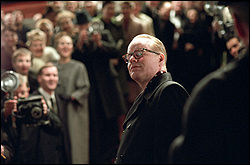“When I think how good the book could be,” Truman Capote confides to a friend about his groundbreaking work in progress, “I can hardly breathe.” Capote (which opens Friday, Oct. 21, at the Egyptian) has exactly the same effect: The quiet perceptiveness of its first minutes, in the stillness of a Kansas farmhouse morning before its four bodies are discovered, suggests that this may be a film so good we can hardly breathe.
Breathe away; nothing will upset director Bennett Miller’s gyroscopically sure balance as he follows the novelist’s intimate involvement with this 1959 case, which ended with the execution of both of the killers and the publication of Capote’s widely heralded “nonfiction novel,” In Cold Blood, in 1966. This is mature, masterly filmmaking, all the more extraordinary for being Miller’s first narrative feature, as well as the first screenplay by actor Dan Futterman (based on Gerald Clarke’s splendid, exhaustive 1988 biography).
The fearless Capote, bird voiced, with the face of an aging infant, is played by Philip Seymour Hoffman, who has seemingly adjusted himself downward, like some Bill Irwin trick, until he seems engulfed by his full-length camel’s hair coat and smothering muffler. But beyond an uncanny appropriation of Capote’s mannerisms, Hoffman gives us all his layers: the charm (which, improbably, works as well for him in Kansas as it does in Manhattan), his oxygen-sucking ego (equaled by his intellect), his journalistic ruthlessness, his genius for manipulation, and his true vulnerability.
Intrigued by aNew York Times item about the seemingly random Clutter family killings, Capote abandons New York, his swell party pals, and his lover, writer Jack Dunphy (Bruce Greenwood). He sets out for Holcomb, Kan., armed only with a New Yorker assignment, a Vuitton trunk for the cashmeres, and Nelle Harper Lee, a friend from his Alabama childhood, recruited to be his “research assistant and personal bodyguard.”
Lee (the superb Catherine Keener) is Capote’s crucial counterpoint, the film’s self-effacing moral center. As the film opens, her own novel, To Kill a Mockingbird, is about to be published, an event almost outside her famous friend’s line of vision. Futterman uses one of Capote’s own tricks—piercing self-revelation—to set their relationship perfectly.
They’re barely settled in their compartment when Capote tries a bit of shameless self- promotion involving the Pullman porter. Lee, no fool, calls him on it: “You’re pathetic,” she laughs; although what their sparring reveals, deftly as any sleight of hand, is the depth, width, and length of their relationship.
In snowy Holcomb, they work the place like pros. Lee gently gets information from the dead daughter’s high-school friends, while Capote, introducing himself widely, initially gets the fish eye from Kansas Bureau of Investigation head Alvin Dewey (Chris Cooper), who asks “What’s The New Yorker?” and tells Capote to line up with the general horde of reporters.
However, Dewey’s wife, Marie (Amy Ryan), knows exactly who Truman Capote is, and before long they’re having dinners at the Deweys’, while Capote, in full raconteur mode, spins tales of life on the set of Beat the Devil, and demonstrates his “94 percent total recall” of anything he’s read or heard. The team has made first base.
The capture and conviction of the killers, Dick Hickock (Mark Pellegrino) and Perry Smith (Clinton Collins Jr.), come early and abruptly, and from his first look at the half-Cherokee Smith, the smallest amount of Capote’s detachment flakes away. As he begins interviewing both men, Capote realizes that their stories contain the germ of something more profound than a magazine article: a book illuminating two Americas—the safe, protected one of the Clutters, and the rootless, amoral one beneath. If he can write it.
Capotegrows taut in the rhythms of its last third, as judicial appeals and reams of interviews mount, and as Capote’s internal dilemma begins to engulf him. Although he’s worked carefully to get both men to trust him, at the cost of his own emotional equilibrium he begins to empathize deeply with Smith, the “artistic” one, the bruised outsider, with whom he shares boyhood abandonment and memories of a mother who killed herself. He tells Lee, “It’s as if Perry and I started life in the same house. One day he stood up and went out the back door, while I went out the front.”
At the same time, the writer’s hundreds of neatly organized pages need the only full stop possible: Smith’s and Hickock’s execution. If in an act of mutual seduction Capote has gotten Smith to believe they were something beyond friends, soul mates perhaps; if he has cajoled and bullied and lied to him to scrape out the last bits of his story, and he has—then it’s no wonder that the final act is nearly excruciating. The price for journalistic ambition has never been so high, so personal, or so perceptible to the naked eye.
Capote‘s pure, almost Shaker style lets us focus on the story’s undercurrents, on what goes unspoken, and on the delicate balance of each of the performances, particularly the interplay between Hoffman and the haunting Collins. Even though the landscape is Manitoba, not Kansas, it has the right windswept, lonely feeling. Although it’s rude to single out only a few of the artists involved, Adam Kimmel’s camera work manages to be modest and exquisitely attuned to all these undercurrents, while Christopher Tellefsen’s editing is both lyrical and, in the final crushing moments, inexorable.








